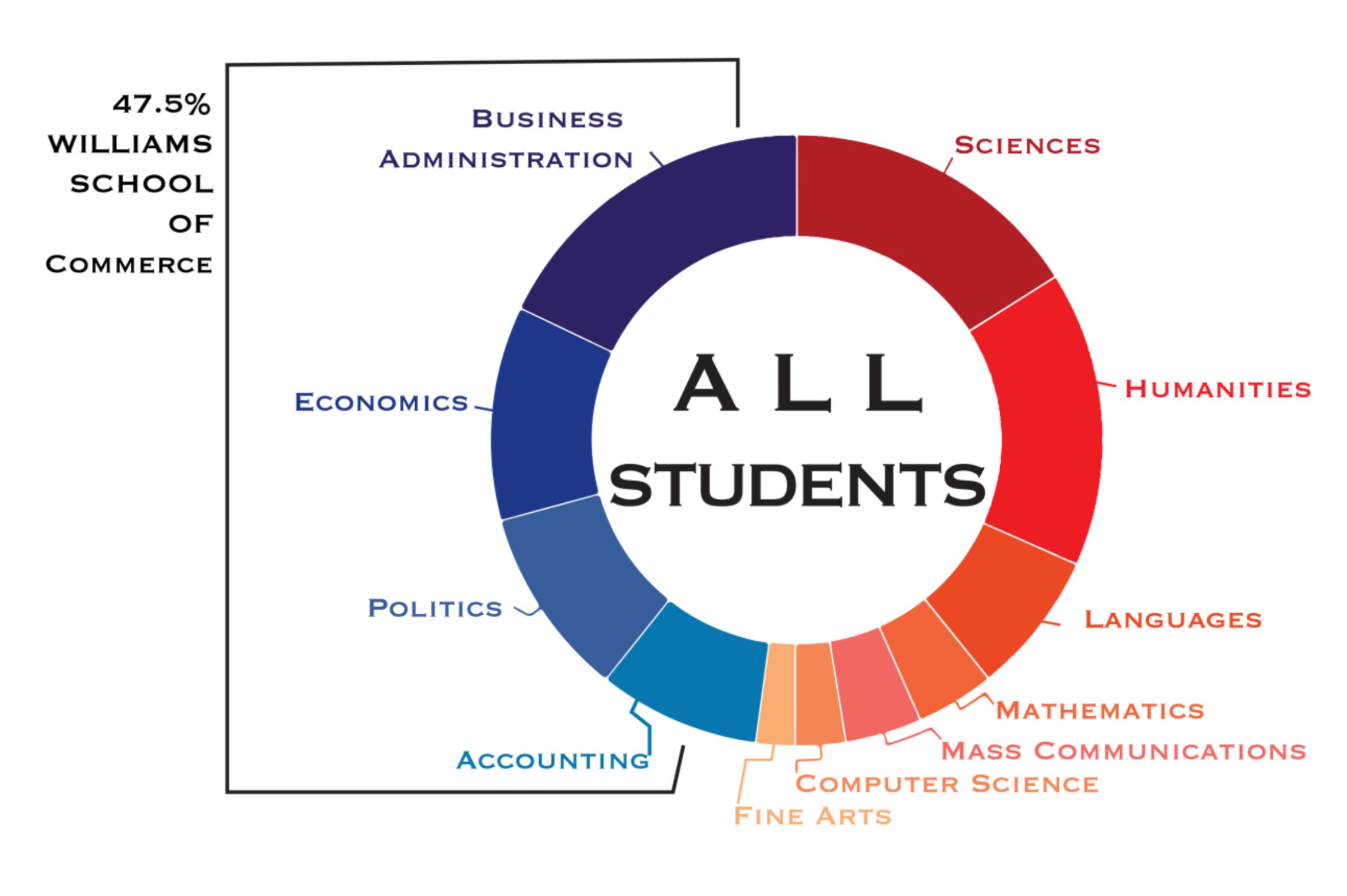The Trends and Imbalances of W&L Majors
As a liberal arts school, Washington and Lee University offers 40 different majors. Yet, half of the student body is concentrated into four majors alone.
The Washington and Lee undergraduate departments are divided into two schools: the College and the Williams School of Commerce. The former offers courses ranging from sciences and humanities to languages and fine arts. The latter offers four majors: Business Administration, Accounting, Politics, and Economics. Although 90 percent of W&L’s offered majors are in the College, almost half of the student body chooses a major within the Williams School, also called the C-School.
“I think some of it has to do with the fact that many of our students come to W&L interested in real world problems and how to solve them,” Head of the Economics Department Professor Linda Hooks said. “Many of the C-School’s majors address that kind of thing.”
Many faculty in the College are aware of the large concentration of students in the C-School. Business Administration, the most popular major in the Williams School, accounts for around 18 percent of the student body. The English major only accounts for about four percent.
“I wish there were administrative pressure to level that particular playing field,” English Professor Lesley Wheeler said. “Lower enrollments translate to reduced resources, which translate to lower staffing, which translates to fewer introductory courses, which translates to fewer opportunities for students to see how terrific and fruitful College majors are.”
Many students in the College acknowledge the overwhelming popularity of the Williams School.
“I often feel as if I’m a minority,” sophomore Hal Fant, a Neuroscience major, said. “In my pledge class of 20, I’m one of three people not in the Williams School.”
Because many students enter W&L undecided on a major, the popularity of C-School can be a deciding factor. Sophomore Shannon Wright did not plan to major in Business Administration initially, but the atmosphere surrounding the C-School was a deciding factor.
“I think the amount of people majoring in Business Administration at W&L probably did sway me a bit,” Wright said.
Many students turn also to the Williams School because they feel it offers “safer majors,” Professor Hooks said. Wright said that students often think that a Business major might lead them along a straighter path to success post graduation; it’s more of a “sure thing.”
Because so many students are interested in the C-School, class registration is tricky. At times, it’s difficult to fit all of the students into the classes offered, Professor Hooks said. Declared majors and seniors are usually given priority, so first-years and sophomores often struggle.
“Registration is so hard. Picking out classes is so difficult because they fill up so fast,” Wright said. “My advisor warned me I might not even get into any business classes my sophomore year. I know seniors need to take the classes, but sophomores need to be on the track, especially if they’re double majoring.”
Although the Williams School and the College offer very different courses, specific majors within each are more popular with specific genders. The Williams School itself is nearly 60 percent male, but many students and faculty are unsure why the gap exists.
“Why the proportion of women who major in economics is lower than the average is a puzzle to us,”
Professor Hooks said.
“The faculty spend a lot of time thinking about that.”
Cognitive and Behavioral Sciences, a major closely aligned with Psychology, is among the courses in the College that draws one gender far more than the other: it is 86 percent female. But, as one of the 11 men in the major, senior Graham Pergande is unbothered by the gap.
“I wasn’t aware of it much when I declared, but I don’t think it would have had a big influence on my decision either,” he said. “Within the classes, it is predominantly female, but I guess I never notice or pay attention to that.”
It’s possible that women gravitate more heavily toward Psychology because it is traditionally seen as a “helping profession.” Societally, helping roles are considered more feminine, Pergande said.
Societal standards and norms may account for the large female majority in the English Department as well, Professor Wheeler said. About 74 percent of W&L’s English majors are female.
“I’m not sure why national gender ratios skew the way they do,” Professor Wheeler said. “Several cultural prejudices are probably at work among students and their parents, although I’m not saying they’re rooted in truth: that women are more verbal, that they should be under less pressure to earn high salaries, that English degrees lead to less lucrative jobs.”
Despite the wide range of classes and career paths that W&L students choose to pursue, many students are happy with their own choices and support and respect the choices of others.
“At the end of the day, I don’t think it’s the major that truly matters, it’s the experiences that you gain throughout your college career that shape you into the person you are years after graduating college,” Fant said. “I am confident that every student who graduates from W&L grows both intellectually and individually, and is equipped with the tools and knowledge to excel in whatever it is they choose to do.”



